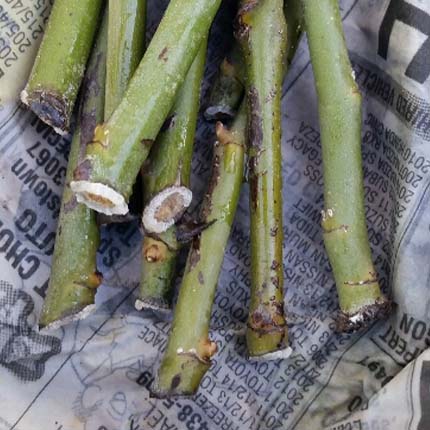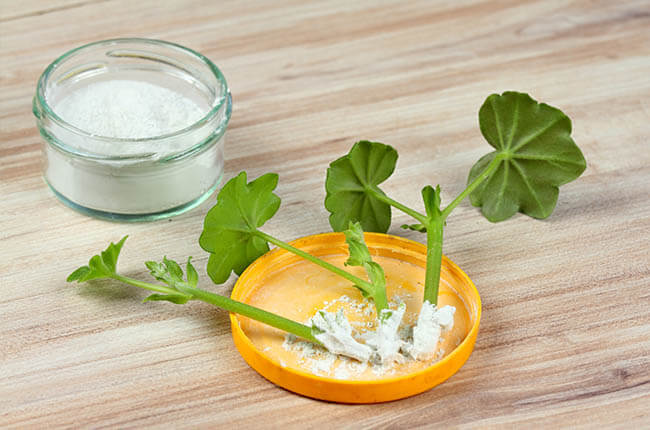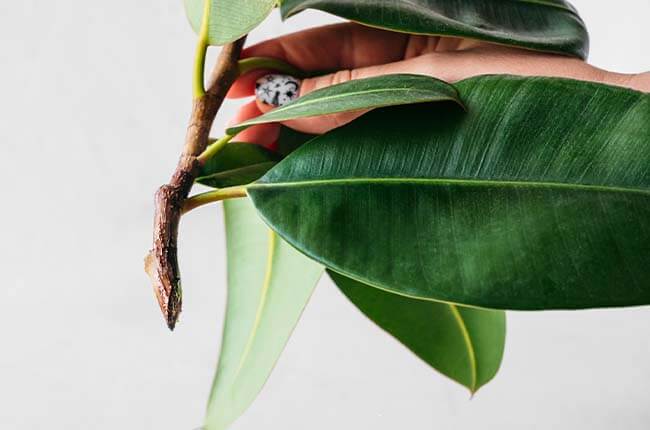If you have propagated stem cuttings before, you must have wondered if you should let them callus for a week or so before planting them into the soil.
And why should you?
Letting stem cuttings callus before propagation is a prerequisite for most plant species (especially succulents and perennials) to develop roots. It reduces the time in propagation, helps make cuttings become more resistant to dehydration, and increases the chances of success in propagation.
In this article, we will take a look at the reasons you should let your cuttings callus over first and how you can do so properly.
1. What is callus on plants?
Callus is a scar or swelling formed over a wound or around the perimeter of the cut surface of a stem.
It grows mainly from the young cells in the cambium, although it can also grow on the cortex and the pith.
Callus can harden and appear white in color because the parenchyma cells are lignified or converted into woody tissues, a process called lignification.
Callus is formed as the plant releases growth hormones to try to heal its wounds, such as auxin to grow roots and cytokinin to grow shoots. Auxin can be found in a rooting hormone product and cytokinin can be found in keiki paste.
New cells grow rapidly to regenerate new roots or shoots. Wounding is thus an important horticultural technique used in vegetative propagation via stem cuttings, grafting, air layering, or tissue culture to propagate new shoots, roots, or an entire plant.
The formation of callus and new roots can also be induced artificially by the application of rooting hormone.

2. Why do cuttings need to callus?
Callus formation makes cuttings to become more resistant to dehydration, shortens the time in propagation, and increases the success in propagation.
This is according to a two-year study by The University of Florida that compares the differences between the stem cuttings from four plant species that are not callused and are directed planted in the soil versus cuttings that are callused in a high humid environment first and are only transplanted to the soil after root initials emerge (Vellejo, Fisher & Hodges, 2018).
The study found that callused cuttings are more resistant to dehydration during the propagation process, and have a lower shrinkage (failure) rate in propagation (under 1% failure rate with callused cuttings versus an average of 4.5% failure rate with direct transplanting) (see table below).
| Plant | Failure rate (not callused) | Failure rate (callused) |
| Bracteantha | 11.9% | 0.3% |
| Osteospermum | 1.5% | 0.9% |
| Pelargonium | 0.6% | 1.2% |
| Scaevola | 3% | 0.6% |
| Average | 4.5% | 0.7% |
Also, the callused cuttings root more quickly and result in less time in crop production (on average a week less) (see table below).
| Plant | Days to liner stage (not callused) | Days to liner stage (callused) |
| Bracteantha | 33 | 23 (-10 fewer) |
| Osteospermum | 33 | 23 (-10 fewer) |
| Pelargonium | 39 | 24 (-9 fewer) |
| Scaevola | 32 | 29 (-3 fewer) |
| Average | 33 | 26 (-7 fewer) |
In fact, for many plant species, callus formation is a prerequisite for the formation of roots. This applies to for example the propagation of rose cuttings (Costa et al., 2013) and avocado tree cuttings (Ernst & Holtzhausen, 1987).
3. How to let cuttings callus?
To let cuttings callus is to let them heal their wounds in a moist, low-bacteria environment to prevent infection. The best way is what is often known as the “newspaper burrito” method.
1. Select stems from mature wood, about pencil thickness. The best time to take cuttings is after the flowers have faded. Each cutting should ideally have 4 buds or nodes. The node area may root more easily.
2. Remove all the flowers and most of the leaves, leaving only one leaf to focus the energy on healing and growing new roots.
3. Make a horizontal cut about 1 mm below the bottom bud. The cut above does not have to be horizontal.
4. To callus the cuttings, wrap 10 to 15 cuttings together in a few sheets of damp (not wet) newspapers or peat moss and put them inside a plastic bag or a container to retain moisture. Herbaceous stems take around 1-2 weeks, and woody stems can take longer from 1 week or up to a month to callus. The idea is to let the cuttings heal the wound in a humid environment without coming into contact with a substrate with bacteria to lower the risk of infection.
Note: do not leave your cuttings in the dry air to callus. Callus formation requires moisture, without direct contact with a substrate with bacteria to lower infection risk.
5. When the cuttings are callused with swelling developed around the perimeter of the cut surface and even with signs of root initials, transfer them immediately to a basic potting mix and water as a regular plant. Be careful the potting mix should not contain any fertilizer as it can burn the new roots. Don’t wait too long for new roots to elongate as the delicate, fragile young roots can break easily.
4. Different treatment for woody stems vs. soft stems?
In general, all plant cuttings benefit from forming callus first for about a week in a cool, humid environment before they are planted in soil.
For perennials with woody stems (e.g. rose, fig trees, plumeria (frangipani)) and succulents with fleshy stems (e.g. echeverias, sansevierias, and crassula), their cuttings must be callused first before they are planted in soil to prevent infection and rotting.
For semi-woody stems (e.g. geranium, rosemary, and lavender) and herbaceous plants with soft, flexible stems (e.g. Philodendron, Pothos), their cuttings can be planted directly into the soil to grow new roots. But if you let them callus first, they will develop roots more quickly and result in a healthier plant.
5. Should cuttings callus before water propagation?
Similar to propagation in soil, all plant cuttings will benefit from being callused over first before they are put in water to propagate.
For succulents, it is even necessary to callus their cuttings before putting them in water for propagation to prevent rotting.
For other plants such as herbaceous plants with soft stems, it isn’t necessary to let them callus first but doing so will increase their chances of propagation and lower the chances of rotting.
6. Should you use rooting hormone?
The application of auxins rooting hormone can help develop roots in callused cuttings.
Auxins are natural plant growth hormones that promote the development of roots. They can be used in liquid or powder form.
It is often applied to cut stems to stimulate stems to callus and develop roots.
But do not use too much root hormone, as an overdose of auxins will stimulate the production of ethylene, a chemical that inhibits cell elongation and, consequently, plant growth.
Apart from rooting hormone, you can apply cinnamon powder which functions as a fungicide to prevent rot and callus formation.

Conclusion
Plant cuttings should callus over for a week before being planted in soil.
Although some plants can still grow roots without being callused over, doing so will nevertheless help them become more resistant to dehydration, thus resulting in a higher success rate in propagation, and a shorter time in developing roots.
A rooting hormone of auxins can also be applied to the stem cuttings to promote root formation.
Happy gardening!
Related
Keiki Paste vs Rooting Hormone: What’s the difference?
6 Reasons Why Air Layering Can Fail (& How to Succeed)
References
Blakesley, D., Weston, G. D., & Hall, J. F. (1991). The role of endogenous auxin in root initiation. Plant Growth Regulation, 10(4), 341-353.
Costa, J. M., Heuvelink, E. Van de Pol, P,A. & Put, H. M. C. (2013). Anatomy and Morphology of Rooting in leafy rose stem cuttings and starch dynamics following severance. ISHS Acta Horticulturae 751.
Firth, S. C., & Trask, A. (2017). Honey as an alternative rooting stimulant for cuttings. University of Hawaii Master Gardener Programm, 21.
Fege, A. S. (1983). The practice and physiological basis of collecting, storing and planting Populus hardwood cuttings. In: Hansen, Edward A., ed. Intensive plantation culture: 12 years research. Gen. Tech. Rep. NC-91. St. Paul, MN: US Department of Agriculture, Forest Service, North Central Forest Experiment Station: 1-11., 91.
Ernst, A. A. & Holtzhausen, L. C. (1987). Callus development-a possible aid in rooting avocado cuttings. South African Avocado Growers’ Association Yearbook, 10, 39-41.
Guan, L., Tayengwa, R., Cheng, Z. M., Peer, W. A., Murphy, A. S., & Zhao, M. (2019). Auxin regulates adventitious root formation in tomato cuttings. BMC plant biology, 19(1), 1-16.
Ogburn, R. M., & Edwards, E. J. (2010). The ecological water-use strategies of succulent plants. In Advances in botanical research (Vol. 55, pp. 179-225). Academic Press.
Vallejo, J. C., Fisher, P. R. & Hodges, A. W. (2018). Cutting Types and Transplanting Strategies. GPN Mag.
- Top 6 Drip Irrigation Systems for Raised Beds (2025) - January 31, 2025
- Top 10 Orchid Fertilizers: A Comprehensive Review (2025) - January 16, 2025
- Top 6 Slow-Release Fertilizers for Houseplants & Veggies (2025) - January 15, 2025

